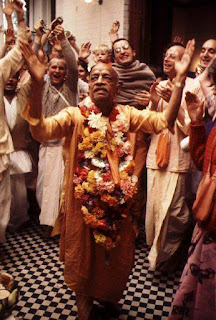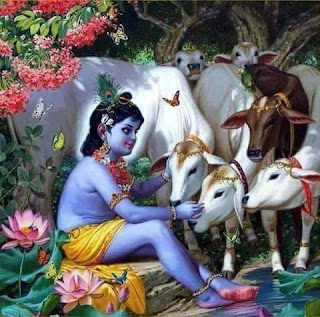By Mahanidhi Swami
Some numbers given in the Srimad Bhagavatam seem too high to believe. For example, (10.12.2): “In the morning when Sri Krishna went to the pasturing grounds, He was accompanied by hundreds and thousands of cowherd boys (prthukaah sahasrashah), and hundreds and thousands of groups of calves (sahasra-upari-sankhyayaa anvitaan).”
What to make of these astronomical numbers? In his tika to Srimad Bhagavatam (10.12.3): Srila Visvanatha Cakravartipada says, “One should not argue that such a large number of cows could not possibly fit into the thirty-two square mile area of Vrindavana, because the holy dhama is unlimited by the inconceivable energy, achintya-shakti of Bhagavan Sri Krishna. Even a small portion of the Vraja Dhama can accommodate billions of universes each measuring fifty million miles in diameter. Krishna showed this fact to Brahmaji in 10.13.
The Srimad Bhagavatam (10.33.38) states Krishna danced with the gopis for a night of Lord Brahma, brahma-ratra upaavrtte, which means several millions and MILLIONS OF YEARS!
In his Sarartha Darshini tika, Srila Visvanatha Cakravartipada compares this inconceivable expansion of time to the fact that many universes fit within the forty-mile range of earthly Vrindavana. In this regard, Srila Rupa Goswamipada says, “In Gokula, nothing is impossible for Bhagavan Sri Krishna, the devotees, the abode, and everything in the abode of Vrindavana, by the power of the Sri Krishna’s inconceivable energy.” (Laghu Bh. 1.5.51)
Scriptures state that when Sri Krishna leaves Nandgrama to go the Rasa Mandala, He arrives there in a few seconds? How can one walk 50 kilometers in a few seconds? Our acharyas state that Krishna’s eternal lila-sthalis, pastime places, are like a lotus flower which opens and closes. To facilitate the movement of Radha-Krishna and Their associates over the vast distances of Vraja Mandala, the lotus closes to shrink the distance between two points. Or it opens to create large distances between places to prevent unwanted persons from approaching and interrupting Their pastimes. Only by the blessings of yogamaya can one understand these transcendental topics.
However, for worshipers of the sweetness within Sri Krishna appearing as His beautiful sweet form, flute playing, loving dealings and pastimes, astronomical numbers reduce the intimate, madhurya conception they hold so dear. Devotees of Radha-Krishna in Vraja only deal in reasonable, sweet numbers which perfectly relate to our human experience, and that of a lovable, cute teenage boy frolicking in the forest with His adorable friends. Here is a list of some sweet numbers and their meanings gleaned from Gaudiya granthas for us to consider:
SWEET NUMBERS:
1. Vrajendranandana Sri Krishna.
2. Radha-Krishna.
3. Ages of Krishna: kaumara, pauganda, kaishora.
Krishna’s: in Vraja, in Mathura and Dvaraka.
Types of prema: sadharani, samanjasa, samartha.
Indulekha-sakhi is 3 days younger than Radha.
4. Features of amorous Krishna hero: dhira…lalita; prasanta; oddhata, odatta.
5. Sthayi-ratis: permanent loving mellow with Krishna.
6. Features of Krishna’s love affairs: love journey, sitting together, support, picking a quarrel, peacemaking, and separation (abhisara, asana, ashraya, kalaha, sandhi, dvaidha)
8. Radhaji’s celebrated ashta-sakhis: Lalita, Vishakha, Citra, Champakalata, Tungavidya, Indulekha, Ranga, Sudevi.
Krishna’s sakha’s kunjas at Shyama-kunda: Arjuna, Gandharva, Kokila, Madhumangala, Sananda, Subala, Vidagdha.
Daily pastime periods: (ashta-kaliya-lila).
Krishna Janmastami: bhadra krishna-astami.
Radha Avirbhava: bhadra sukla-astami.
Heroine gopis: abhisarika, vasaka-sajja, utkanthita, khandita, svadhina-bhartrka, kalahantarita, vipralabdha, proshita-bhartrka.
Sattvika-bhavas: experienced in relation to Radha-Krishna.
10. Age of 10.7 months Krishna left Vrindavana.
11. Age of Vasanta-sakha.11.4 months Kokila-sakha.
12. Main forests of Vraja Mandala.
Age of Gandharva-sakha; 12.6 months, Subala.
Body ornaments of Radhaji.
13. Age Rupa-manjari 13.6 months.
14. Age of Vishakha and Sri Radhika (14.2 months15 days).
Older than Radha by 2 days Champakalata; Lalita 27 days; Younger by 3 days Indulekha; 5 days Tungavidya; 10 days Sudevi & Ranga; 26 days Citra;
Ujjvala, Vidagdha and Sananda-sakhas 14 years.
15. Age of Krishna (15.9 months 7 1/2days).
Groups of Krishna’s gopi lovers.
16. Age of Balarama and Sridhama.
Kunjas around Shyama and Radha-kunda.
Varieties Radha’s body and flower ornaments.
17. Sevas of sakhis and manjaris for Radha-Krishna joy.
19. Symbols on bottoms lotus feet of Radha-Krishna.
25. Qualities of Sri Radha; Rooms in Radha’s Varsana palace.
30. Rooms in Radha’s Yavata home.
33. Sanchari-bhavas experienced in Radha-Krishna prema.
50. Rooms in Nanda Baba’s palace, the home of Krishna.
60. Dandas: 24 minute pastime periods in Radha-Krishna’s blissful day.
64. Qualities of Sri Krishna.
Arts; perfectly and completely seen in Radha-Krishna.
Main sakhis and 64 main manjaris serving under Radha’s ashta-sakhis.
96. Total amorous features of hero Sri Krishna.
360. Varieties of gopi heroine lovers of Krishna.
Jai Jai Sri Radhe !!!



